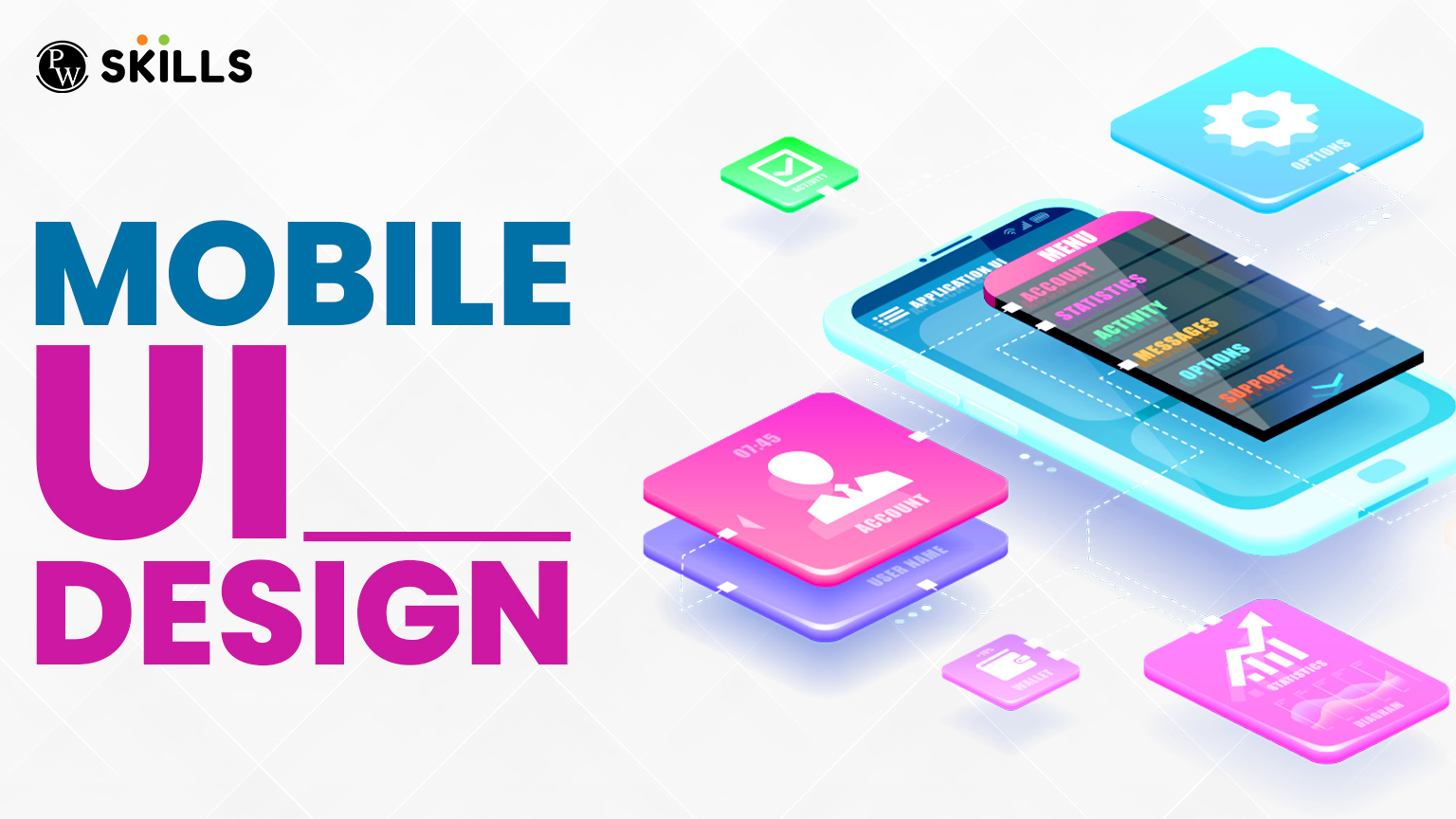Mobile UI design is much more than simply picking colors and buttons. It’s about how users feel while using your app, interact within it, and remain engaged. Whether you are a student stepping into design or a working professional trying to acquire more skills, grasping Mobile UI Design is fundamental in creating applications that people enjoy using. The best part is that with proper coaching, it is quite an easy skill to acquire.
Mobile UI Design, in short, is the intermediary between the user and the application. It is all about making the interaction as smooth, useful, and delightful as possible. Looking out for mobile screens, which are generally small and touch-responsive and used on the go, the Mobile UI is, thus, to be set up fast, minimal, and most easy to understand.
Good Mobile UI Design Practices: Putting Theory to Practice
-
Simplicity Rules
Allowing for a clean and uncluttered layout enables users to achieve their goals fastest. With that said, avoid introducing more colors, icons, or pop-ups.
-
Be Consistent
Consistent use of typography, icons, and gestures throughout the app comes off as friendly and instills confidence in the user.
-
Finger-Operable Design
Design buttons users can tap with one hand. Avoid placing important components in the inaccessible corners of the layout.
-
Clarity in Navigation
Users should always know where they are and how to go back. Use familiar patterns like tab bars, breadcrumbs, and back buttons.
Mobile UI Design: 10 Mobile UI Design Examples That Will Inspire You
If you want to learn from reality, Mobile UI Design will understand all successful principles through analyzing successful apps for the student or working professional. The best way to understand what works in mobile UI design is to analyze real-world examples. Here is a curated list of 10 excellent mobile UI design examples, excellently executed as aforementioned:
-
Duolingo – Gamified Simplicity
Duolingo’s mobile UI design is a master class in gamification and visual simplicity. It uses progress bars, rewards, and clean layouts to keep the user user-motivated and engaged.
-
Spotify – Personalized Discovery
Personalized music recommendations, intuitive navigation, and bold, modern visuals with on-brand features are what Spotify does perfect in mobile UI design.
-
Headspace – Calm and Minimalist
Headspace shows how today’s mobile UI design can be focused on mental wellness. Simple design, pastel colors, plus smooth animation provide an enjoyable calming experience.
-
Airbnb – Frictionless Interaction
From filtering stays to booking finalizations, the mobile UI design that Airbnb provides is intuitive but not overtly trustworthy nor harsh at those who are very elegant.
-
Zomato-Rich Visuals & Navigation
Accurately, the mobile UI makes Zomato a pleasure to see what restaurants have to offer without draining the user because of all the content one would be able to find.
-
Trello – Neatly and Interactively Organized
One of the best mobile UI designs for productivity apps is limited by its cards style interface. It is clean, drag-and-drop capable, and scales marvelously to mobile screens.

-
Instagram – Consistent & Familiar
Instagram’s UI has evolved without baffling that user. The ever-familiar navigation bar, storytelling layout, and interaction design keep users attached.
-
Google Maps – Utility Meets Cleanness
Google Maps blends technical functionality with clearness and thus demonstrates that even the most complex apps can be really easy to use with smart mobile UI design.
-
Notion – Functional Minimalism
Notion is a pure minimalist powerhouse in mobile UI design backed by deep content creation with pristine aesthetics.
-
Netflix – Visual-First Browsing
Netflix uses a visual-first UI approach. Thumbnails, preview videos, and smart categorization keep the user rolling in and out of the app while they end up watching.
These mobile examples in UI design are true representations of core principles from clarity and minimalism to personalization and interactivity. By studying such interfaces, one can start identifying patterns and features that define the best mobile UI design trends today.
Current Mobile UI Design Trends to Follow
A very important thing when it comes to following trends is that it ensures that your mobile UI design appears fresh and relevant. Foremost in vogue in 2025 are
-
Glassmorphism and Neumorphism
This implies that UI elements were semi-transparent with depth and shadows, giving a very futuristic yet clean look.
-
Voice Interface Integration
The presence of Alexa and Siri has conditioned behavior so that now apps are integrating voice commands and feedback into their UI.
-
Thumb-Friendly Zones
Designers are now mapping layouts to thumb-reach zones- buttons and CTAs live where fingers naturally land.
-
Dark Mode Done Right
Dark Mode saves battery and reduces eye strain. This is something that many apps have started doing with adaptive Mobile UI Design.
-
Micro-Interactions
Small animations, like a heart bouncing when you “like”, add flavor and provide light guidance to users.
![]() Join Our UI/UX Telegram Channel
Join Our UI/UX Telegram Channel
![]() Join Our UI/UX WhatsApp Channel
Join Our UI/UX WhatsApp Channel
The Modern Mobile UI Design: Trends to Follow
Designs Should Remain Updated with the Implementation of Holding Trend-Free At Present
By staying abreast of current trends in mobile UI design, you can rest assured that your program will appear and feel relevant. This is what helps to satisfy user expectations and maintain high engagement.
Neomorphism is gaining traction now. It utilizes very subtle shadows and highlights to give an impression of softness and almost 3D. Dark mode has become a standard now- not just for aesthetic reasons, but also since it saves battery and is easy on the eyes.
We are also witnessing a growing popularity of Voice UI, allowing the user to speak instead of type, whereas gesture-based navigation utilizes swiping and pinching for better UX.
These contemporary approaches to mobile UI design feel fresh, yet they also enhance accessibility and usability. If employed judicially, they can provide a winning edge to your app.

Mobile UI Design Launch Checklist
Mobile UI Design Checklist Before Launch
Before going live, use this mobile UI design checklist to ensure a polished product:
- Are all interactive elements accessible and responsive on all screen sizes?
- Is the navigation logical and easy to use?
- Are touch targets large enough for all finger sizes?
- Do all visual elements maintain consistency in style and tone?
- Is the font readable across bright and dark modes?
- Have you tested the interface with real users?
- Is the app optimized for low internet speed scenarios?
- Are error messages clear, helpful, and human-friendly?
Tick these off, and you’re already ahead of 80% of poorly designed apps.
Ask Yourself Now:
- Is your app responsive across different screen sizes?
- Is it readable on different colors and in different light conditions?
- Is any interaction feedback easy to notice without being obnoxious?
- Can users find and use your CTAs?
- Is the navigation sleek with an obvious path?
- Are the loading times acceptable?
This Mobile UI Design checklist acts like your quality assurance team. It helps catch small issues before they turn into big user complaints.

Mobile UI Design: Common Mistakes and Things to Avoid
Many designers unknowingly make errors that hurt the user experience:
- Messy screens
- Overuse of animation
- Poor distinction between text and background
- Inconsistency in design language
- Ignoring platform guidelines
A well-thought-out mobile UI design considers the user’s time, device, and expectations.
User Interface Mobile UI: How It Affects Engagement
Great mobile UI design directly impacts how long users stay on your app and whether they return. Confusing and frustrating apps face the highest uninstall rates. Well-versed in user interface mobile design, highly intuitive design interfaces lead to an increase in user actions, better reviews, and cherished loyal users.
Your users give judgment about your application within 5 seconds. Make every second count.
Best Tools for Creating Amazing Mobile UI Designs
Here are tools that are popular with students and professionals alike:
- Figma – Collaborative design tools for prototyping and UI workflows.
- Adobe XD – Everything good in wireframing and user flows.
- Sketch – Easy to use and popular for iOS app UI design.
- Canva Mobile UI Templates – Quick and entry level for practice.
- Framer – Best for advanced animation benefits in Mobile UI Design.
Also Read:
- UI UX Design Roadmap 2025: Your Step-by-Step Guide to a Creative Career
- 20+ UI Developer Interview Questions and Answers
- Motion UI: What Is It, Why It Matters & Stunning Motion UI Design Examples
- What Is UI Design Certification? A Complete Guide for Aspiring Designers
Do You Want to Master UI Design with Experts?
Get UI/UX from PW Skills
PW Skills’ UI UX Course takes you through real-world mobile UI design, whether you’re a budding professional or a working one:
- Practice real-world mobile UI design.
- Projects and quizzes
- Get mentorship from experienced designers.
- Advance your career with industry-backed certification and job-ready skills.
Enroll in the UI/UX Course by PW Skills
Mobile UI design is not a skill—it is art
Mobile design is more than shiny features; in reality, it is developing meaningful interfaces to solve discrete real-life problems. From applications that we use every single day to those that get uninstalled, mobile UI makes every experience.
Whether you’re aspiring to be a product manager, UI designer, or just curious about how the users go through it, it’s certainly the most intelligent way to create an impact for learning mobile UI design.
Mobile UI Design FAQs
What really distinguishes Mobile UI Design from the desktop UI?
It focuses on smaller screens, touch navigation, and moving with them on-the-go, so it has simpler structures and quicker interaction.
How can I practice Mobile UI Design as a beginner?
Redesign the UIs of some popular apps like Instagram or Paytm with free tools like Figma or Canva. Analyze what works and does not work.
Does Mobile UI Affect App Downloads?
Yes. An application with a poor UI is quickly uninstalled and badly rated, whereas good design attracts users to install the app.
Do I really need coding skills to learn Mobile UI Design?
Not at all. Many Mobile UI Designers work closely with developers. Figma is one of those tools that make designing without writing a single line of code possible

